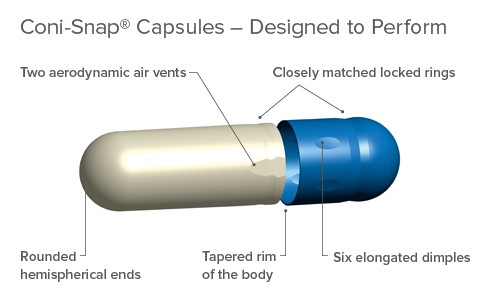THE SURPRISING
HISTORY OF CAPSULES
CURIOSITY

Capsules are everywhere. Today, more than 18 percent of all medicines are delivered in capsules making them one of the most globally recognized forms. Capsules are still the most preferred dosage form. The 2020 Supplement, Over-the-counter and Rx Database (SORD) study from the Natural Marketing Institute shows 42% of supplement users prefer products in a capsule form in the US. Preference among heavy users of supplements is even higher—56%.
INTRODUCTION
Their history dates back to the Ancient Egypt, where both western medicine and pharmacy trace their roots. In a papyri dated from about 1500 B.C., 811 mixtures were referenced and their means of delivery was described as “medicines for internal application are given in the form of infusions, injections (meaning enemas), pills, tablets, pastilles, capsules, powders, potions and inhalations.”
The next reference to capsules in literature didn’t come until 1730 when a traveler wrote about a Viennese pharmacist, de Pauli, who created an elliptical capsule from starch. It was designed to cover the bad taste of the pure turpentine he prescribed for gout.
ANCIENT AND NOT-SO-ANCIENT HISTORY
MISSY LOWERY
Integrated Marketing Specialist | United States

Bio...

Ms. Lowery retired from Capsugel/Lonza in 2019. Her career spanned Director of Integrated Marketing for Amgen, Global Strategic Director, Marketing Communications, for Bausch & Lomb Surgical, Chiron Vision and IOLAB, a Johnson & Johnson company, and as vice president at Ogilvy & Mather, Grey and H&S advertising agencies. Her B.S. is from the University of Nebraska and M.S. from Syracuse University.
The first patent for a capsule form was issued about 100 years later in Paris. French pharmacy student Franciosi Achille Barnabe Mothes, along with pharmacist Joseph Gerard Auguste Dublanc, devised a means to create “bladders made of gelatin” and applied for a patent in 1833. They used a small leather bag filled with mercury and dipped it into a gelatin solution. As soon as the film of gelatin dried, the mercury was removed and the gelatin capsule stripped off the bag. The empty capsules were filled with liquids and the opening was sealed with a drop of gelatin.
The French granted Mothes the patent in 1834. That same year he filed a supplementary patent in which the leather bag was replaced by a piece of metal in the shape of an olive. This created a more regular form and improved the efficiency of the process.
The invention was so successful that almost immediately others started producing capsules - from Bucharest to New York to Berlin. Patent law was not uniform so applicants sought ways to circumvent Mothes’ patent. A Bavarian doctor in Munich succeeded in obtaining a patent for a process for making gelatin drug capsules, when just a few years earlier another application was denied on the grounds of infringement.
THE FIRST CAPSULE PATENT
In 1846, Jules Cesar Lehuby was able to circumvent Mothes’ patent by applying for a method to make ‘medical coverings’. His original design called for a combination of wheat starch, sugar and coloring agents. He later changed to vegetable gelatin extracted from moss. But his real break-through was with a patent for producing two-piece hard gelatin capsules made by dipping metal pins into a gelatin solution. These cylindrical shells became the precursor for modern capsules.
In the United States, the New York firm of H. Planten manufactured two-part capsules after 1836, but their usefulness was impaired by their poor fit. Most capsules were still made by pharmacists who also filled them. The two most common ingredients for capsules were either gelatin or starch. Innovations included more practical apparatus for producing and filling elliptical two-piece capsules and machines that were capable of closing capsules.
CIRCUMVENTING THE PATENT AND DISCOVERING THE 2-PIECE
In 1868, a Detroit Pharmacist, F. A. Hubel, made molds of iron wire mounted on wooden blocks which could be dipped into a gelatin solution. By using pins of different diameter for the body and cap, Hubel could produce sections which could telescope into each other. By 1874, Hubel had begun industrial production of empty gelatin capsules. He also introduced a system of numbering capsule sizes with 00 for the largest and 5 for the smallest. He sold his entire output to Parke, Davis & Company in Detroit, and received the first of a series of patents in 1877.
Despite patents, other small companies emerged in the area, making capsules for their own pharmaceutical products or for other companies. Many were consolidated by James Wilkie into the U.S. Capsule Company. About 1900 the firm was purchased by Parke, Davis & Company. Wilkie continued with the company and is credited with producing materials better than iron for the capsule molds—which remained in use until replaced by stainless steel in the 1930s.
FROM IRON WIRE TO STAINLESS STEEL
When automatic filling machines were perfected in the 1920’s—the demand for capsules was on. John B. Russell of Detroit had patented a process for making gelatin coatings which was first made use of by the Parke, Davis & Co. in 1888. The company improved the manufacturing process and in 1895 Arthur Colton patented – on behalf of the company – a machine with an hourly capacity of between 6,000 and 10,000 units.
In 1931, Arthur Colton, on behalf of Parke, Davis & Co. designed a machine which simultaneously manufactured both bodies and caps and fitted them together to form a hard gelatin capsule. The body and cap could be made in different colors and the finished product was shipped in a pre-closed form that would be pushed close during the filling processes. As one author wrote, “It is amazing to realize that a machine originally built in 1931 still represents the basic design of today’s machinery.”
AUTOMATIC FILLING MACHINES DRIVE THE DEMAND
Other design innovations quickly followed. As late as 1968, capsules had straight, plain walls. This was replaced by a series of notches and grooves which ensured provisional pre-lock for the two piece design before filling and a groove and tapered rim to ensure closure and lock after filling - especially important on high-speed filling machines.
INNOVATIONS MOVE TO DESIGN

So what is driving innovation today? The simplicity of the capsule form means the potential for speed in development and manufacturing. Between 2010 and 2015, twenty-one new encapsulated products were approved in the US by the FDA through accelerated pathways. These are new drugs that address unmet medical needs in the treatment of serious or life-threatening conditions. Eliminating the fillers, binders, lubricants, disintegrants and surfactants needed in tableting simplifies the formulation process - speeding product validation and development. With smaller patient populations and the need to target more personalized nutrition, capsule flexibility has become an essential part of innovative product development - to the benefit of patients and consumers.
SO SIMPLE — WHAT IS OLD IS NEW AGAIN
The consumer is also are driving the evolution. In the 2020 SORD study, researchers found that the top reason supplement users prefer a capsule is they find them easier to swallow—72%. We found this true when we fielded the first Capsugel Attitude & Usage study in 2002. Then, as now, all consumers rate characteristics associated with swallowability, efficacy, taste and quality to be the most important in a dosage form. What continues to grow and change is the demand for new materials, transparency in their sourcing and improvement in their functionality. Plant-based, excipient-free, vegetarian, vegan, non-GMO, Clean Label, no preservatives capsules along with functionality that eliminates the need for coatings or multi-component capsules that can reduce the number of pills or capsules that improve the absorption of ingredients are all part of the evolving history of capsules.



